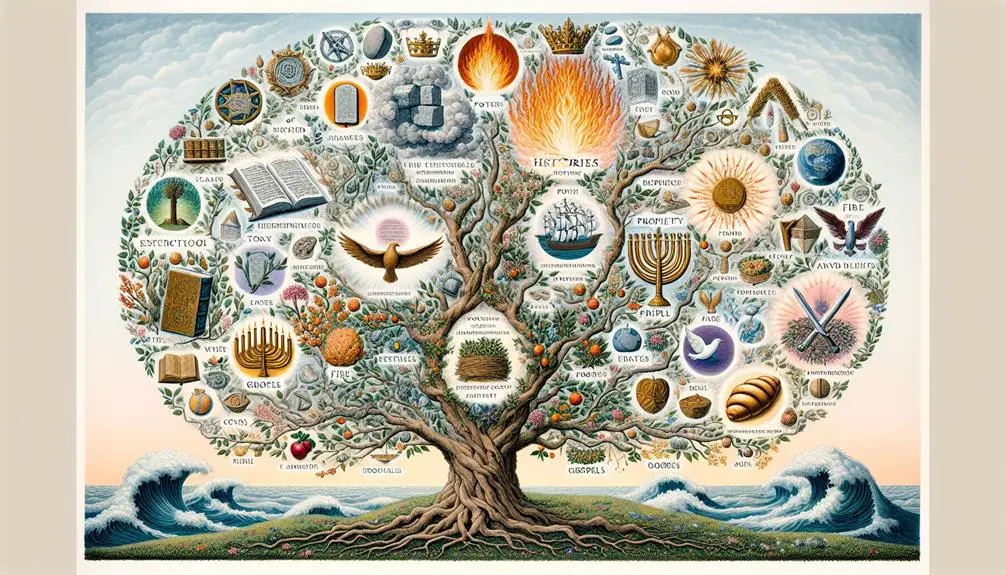A journey through the Bible's structured maze reveals hidden connections, inviting deeper exploration into its historical and thematic layers.

Order in the Bible Scriptures
Navigating the Bible's landscape can sometimes feel like traversing a vast, mysterious maze—you know there's a path through it, but finding that path can seem daunting.
You've likely noticed its complex structure, weaving together history, poetry, prophecy, and letters, each with its own place and purpose. Understanding this order isn't just about knowing which book comes next; it's about uncovering the deeper harmony within the Scriptures.
As you explore the historical context, thematic arrangements, and the unique approach to prophetic literature, you'll discover keys that unlock a more profound comprehension and appreciation. Let's embark on this journey, keeping in mind that the order is not just a sequence, but a gateway to deeper insights.
Key Takeaways
- Canon formation and translation variations impact the structural order of the Bible.
- Historical and cultural contexts influence the chronological arrangement of scriptures.
- Thematic and literary analyses offer alternative approaches to organizing Bible content.
- Understanding prophetic literature requires attention to symbolic language and historical background.
The Structure of the Bible

Delving into the structure of the Bible, it's essential to understand that this sacred compendium is divided into two primary sections: the Old Testament and the New Testament. This division is foundational in grasping the overall narrative and thematic progression within Christian and Jewish traditions. Yet, an analytical and methodical examination reveals complexities beneath this straightforward segmentation, particularly concerning translation variations and canon formation.
Canon formation, a meticulous process, significantly influenced the Bible's structure. It wasn't a spontaneous or arbitrary collection but a result of centuries of theological debates and councils determining which texts were divinely inspired. You'll find that the canon of the Bible varies among different Christian denominations and Judaism, reflecting divergent theological perspectives and historical contexts. This variability underscores the importance of understanding the criteria and processes behind canon formation to appreciate the current structure of the Bible.
Moreover, translation variations have added another layer of complexity to the Bible's structure. As the scriptures were translated from their original languages (Hebrew, Aramaic, and Greek) into Latin and subsequently into countless other languages, nuances in language and cultural contexts led to variations in interpretation and organization. These translation efforts, while aimed at making the scriptures accessible to a wider audience, also resulted in debates about the most accurate and faithful renditions of the original texts.
Historical Context of Scriptures

Understanding the historical context of the scriptures is crucial for comprehending their profound impact on various cultures and societies throughout history. The scriptures have not existed in a vacuum; they've been shaped by, and in turn have shaped, the cultural and historical landscapes in which they've been embedded. This reciprocal influence underscores the importance of delving into the historical backdrop against which these texts were written.
Era |
Cultural Influences |
Translation Variations |
|---|---|---|
Ancient |
Formation of religious beliefs |
Initial translations, prone to interpretive errors |
Medieval |
Church dominance in societal ethos |
Latin predominance, limiting access |
Renaissance |
Humanism and questioning of religious dogmas |
Move towards vernacular translations |
Enlightenment |
Rationalism and secularism rise |
Critical editions, questioning authenticity |
Modern |
Globalization and pluralism |
Numerous versions, increased accessibility |
Each era brought its own cultural influences to bear on the scriptures, affecting both their interpretation and their dissemination. For instance, during the Renaissance, the push towards translations in the vernacular made the scriptures more accessible to the general populace, altering the religious landscape by democratizing access to these sacred texts. Conversely, the Enlightenment period introduced a more skeptical approach to scripture, with critical editions emerging that questioned previous interpretations and the authenticity of certain passages.
Moreover, translation variations over time have not only reflected the linguistic and cultural shifts of each period but have also shaped the understanding and reception of the scriptures. These variations highlight the dynamic nature of the scriptures as living documents, continually reinterpreted in light of changing cultural norms and scholarly insights.
Chronological Reading Guide

Embarking on a chronological reading of the Bible scriptures offers a unique lens through which to view the unfolding of religious narratives and historical events. This methodical approach aligns the scriptures in the order of their historical occurrence, rather than their placement within the canonical text. It provides a coherent timeline, enhancing your understanding of the temporal context in which these events transpired and were subsequently recorded.
The reading benefits of this approach are manifold. Firstly, it facilitates a deeper comprehension of the Bible's historical and cultural backdrop, allowing the mosaic of biblical history to emerge more clearly. This chronological sequence aids in discerning the development of theological themes and the evolution of religious practices over time. By witnessing the progression of events as they happened, you're able to grasp the causal relationships between different narratives, offering insights that might remain obscured in a non-chronological study.
Moreover, personal reflections become more profound as you traverse the Bible's timeline. Observing the continuity of God's interaction with humanity from Genesis to Revelation encourages a reflective examination of your own faith journey in relation to the broader divine narrative. It's an invitation to place oneself within the ongoing story of faith, interpreting personal spiritual experiences through the lens of biblical history.
In essence, a chronological reading of the Bible not only enriches your understanding of the scriptures but also deepens your personal connection to the text. This approach, while requiring a methodical and disciplined reading strategy, promises a rewarding exploration of the Bible's depth, enhancing both knowledge and personal faith.
Thematic Arrangement Insights

Exploring the Bible through a thematic arrangement offers a different lens, highlighting the interconnectedness of its teachings and stories across various books and chapters. This methodical approach reveals patterns and themes that might be overlooked in a more linear or chronological reading. It dives deep into the complex tapestry of literary genres present within the Bible, from poetry and wisdom literature to law codes and narrative histories, each contributing unique insights into the divine message.
As you delve into thematic studies, you'll encounter ongoing authorship debates that add layers of intrigue and depth to your understanding. These discussions not only shed light on the historical context and potential biases of the texts but also challenge you to consider the implications of multiple perspectives on themes such as justice, mercy, and redemption. Engaging with these debates requires a critical eye and an open mind, pushing you to question and reflect rather than passively absorb.
This analytical journey through the Bible's thematic arrangement emphasizes the importance of context. Recognizing the diversity of literary genres and grappling with authorship debates enhances your appreciation for the Bible's complexity and richness. It encourages a more nuanced interpretation of scriptures, where themes aren't confined to single books but woven through the entire biblical narrative.
Navigating Prophetic Literature

Delving into prophetic literature requires a keen eye for its symbolic language and an understanding of its historical context. To navigate its complex narratives and uncover the layers of meaning, you must approach these texts with both reverence and a critical mindset. The prophetic books aren't just ancient artifacts; they offer insights that resonate with modern relevance, challenging readers to see beyond the surface.
To aid in your exploration, consider these visual elements often found in prophetic literature:
- Fiery visions that symbolize divine judgment and purification.
- Flowing rivers representing life, renewal, and the movement of God's spirit.
- Desolate landscapes indicating times of trial, desolation, or divine displeasure.
- Beasts with multiple heads or wings pointing to various empires or political powers.
- Precious stones and metals illustrating purity, value, and the unshakable nature of God's promises.
Symbolic interpretations of these elements require you to dig deep into the socio-political and religious context of the times. Understanding the historical backdrop against which these prophecies were made is crucial. It's not merely about predicting future events but about speaking truth to power, offering hope, and calling for repentance and change.
As you dissect these texts, ask how their messages apply today. The themes of justice, mercy, and faithfulness are as relevant now as they were centuries ago. Through careful study, you'll find that prophetic literature bridges the ancient and the contemporary, inviting you to reflect on your own place in the ongoing narrative of faith.
Frequently Asked Questions
How Do Different Bible Translations Impact the Perceived Order and Coherence of Scriptures?
Different Bible translations can significantly alter your perception of the scriptures' order and coherence. Translation variations, influenced by cultural nuances and linguistic differences, may shift the emphasis or meaning of certain passages. This can lead to a varied understanding of the text's structure and narrative flow.
As you analyze these differences, it's crucial to consider how translators' choices, shaped by cultural influences, impact your interpretation of the Bible's coherence.
What Role Do Apocryphal Books Play in Understanding the Canonical Order of the Bible?
Right off the bat, it's essential to note that apocryphal books shed light on the canonical order of the Bible by offering additional historical context and exploring various literary genres.
This deep dive into lesser-known texts enriches your understanding, as these books provide a broader perspective on the scriptural landscape. They serve as a bridge, filling gaps and offering insights that help you grasp the Bible's composition and its profound complexities more methodically.
How Do Various Religious Traditions Interpret the Order of Books Differently Within Their Versions of the Bible?
Different religious traditions interpret the order of books in their Bibles based on historical context and cultural variations. You'll find that these differences aren't random but reflect deep theological and liturgical priorities.
For instance, the arrangement in a Catholic Bible differs from a Protestant one, showcasing how traditions emphasize certain texts. Analyzing these variations methodically reveals how each tradition uniquely understands the biblical narrative, showcasing a rich tapestry of interpretation and faith.
In What Ways Does the Order of Bible Scriptures Influence Modern Theological Debates or Doctrines?
Interestingly, you mightn't realize how much the sequencing of biblical texts shapes modern theological debates. The order affects interpretations by emphasizing certain historical contexts or literary genres, guiding readers' understanding.
For instance, placing prophetic books earlier can highlight predictive elements, affecting doctrines about prophecy. Similarly, the arrangement influences how historical narratives are perceived, potentially altering doctrinal emphasis on covenant or salvation history.
This methodical analysis reveals the intricate relationship between scripture order and theological perspectives.
How Do Digital Formats and Bible Apps Change the Traditional Understanding of Scriptural Order and Accessibility?
You'll find that digital formats and Bible apps significantly impact your access to scriptures and how you engage with them.
The user interface shapes your reading patterns, making it easier to navigate, compare, and understand different passages. This technology offers a unique approach to scripture study, allowing for personalized and in-depth exploration beyond traditional linear reading.
It's a shift that could redefine your scriptural engagement and interpretation in profound ways.
Conclusion
In exploring the Bible, you've journeyed through its intricate structure, delved into the depths of its historical context, and followed a path through its chronology and themes.
You've navigated the complexities of prophetic literature, weaving through the tapestry of time and thought.
This exploration isn't just an academic exercise; it's a quest for understanding, a methodical unraveling of truths that have shaped human history.
As you continue, remember: every verse, every chapter, carries layers of meaning, waiting to be discovered, analyzed, and appreciated.



Sign up